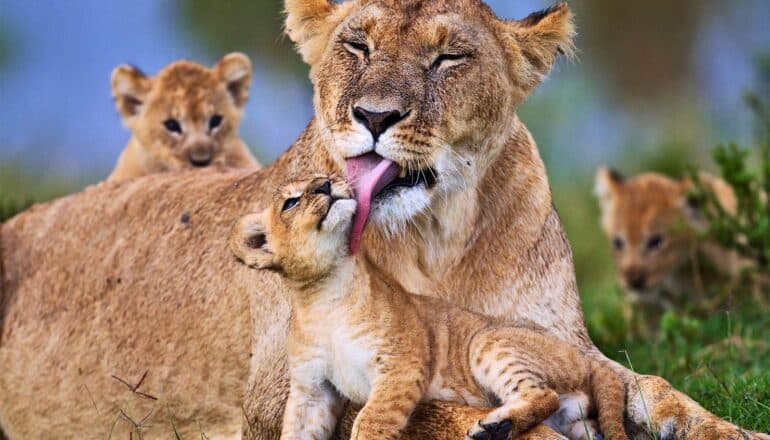Humans are one of the biggest threats to lions
- Humans are one of the biggest threats to lions, responsible for an average of 22 lion fatalities per year in areas around Etosha National Park.
- The study found that there was no single reason behind the killings, but rather a combination of environmental, cultural, and climatic factors.
- Lions are more likely to be killed when they venture outside the park during the cold, dry season due to reduced prey availability and increased conflict with humans over livestock.
- The presence of lions in areas surrounding Etosha National Park can lead to human-lion conflict, with farmers viewing lions as a threat to their livelihoods and using lethal options to deal with them.
- Researchers suggest that integrated conservation efforts could reduce the negative impacts of human-lion conflict by promoting coexistence and providing economic benefits through tourism ventures and employment opportunities.

Lions face a variety of threats, but humans are one of the biggest, according to new research.
From 1980 to 2018, humans killed 698 lions in the areas around Etosha National Park in northern Namibia. That’s an average of 22 dead lions per year, but researchers say that’s likely an underestimate.
The new study found there was no single reason behind the killings.
“It was environmental. It was cultural. It was climatic,” says Dipanjan Naha, lead author of the study and a researcher at both the University of Georgia’s Savannah River Ecology Laboratory and Ongava Research Centre in Namibia.
Etosha National Park is one of the largest safe havens for lions and a hotspot for wildlife tourism.
The study showed the highest number of lion fatalities occurred during the cold, dry season from May to August. This is also the time when lions cross the Etosha perimeter fence and move outside the park.
When there’s less available water, there is also less prey, leading lions to venture outside the park. This brings them to the livestock and game farms surrounding the park, which, in turn, leads to conflict with people.
“When lions move from Etosha to the neighboring farms or communal lands, they encounter wild prey and livestock,” says Naha. “So, these lions think, ‘Maybe that is a good habitat for me to settle down in.’ But when they end up there, they get shot.
“Areas around the park are kind of an ecological trap for them. As soon as the lions get out of the park, they are in trouble with the farmers.”
Places with more vegetation saw fewer fatalities, as lions were able to hide better from humans. Younger males, however, were more likely to be killed than females, as they are often pushed out of territories controlled by dominant prides.
The Etosha region saw frequent droughts in the 1990s and 2000s, forcing farmers to switch from livestock to game farms. Game farmers were less tolerant of the carnivores’ presence due to the higher cost of game.
Figuring out why lions are being killed is key to protecting the animals, the researchers say.
Typically, people who kill lions are simply trying to protect their livelihoods, the researchers say. Lions hunt and eat the livestock farmers depend on to support themselves. In their view, the farmers are just defending their animals. Commercial farmers aren’t compensated when carnivores kill their animals, so they use lethal options to deal with them.
This is worsened by the fence splitting the region. It was built to prevent the spread of disease, with farms on the northern side forbidden to sell their meat south of the fence or in other countries.
“That line created an economic division and a motivation for people who are living on the southern side to say, ‘If a lion is coming and killing our livestock, then it’s a direct threat to our livelihood,’” Naha says. This may have encouraged more lethal options for dealing with lions.
People seeing lions as a threat used to be far less common.
Etosha National Park was once inhabited by the indigenous hunter-gatherers who were used to living alongside the big cats. But Europeans settling in the region likely viewed lions as a threat to their safety—and they had firearms to deal with that perceived threat.
It may be possible to return to living peacefully alongside lions, though.
“There has to be more integrated conservation where humans and wildlife can share spaces, but the negative impacts of lions getting killed or people’s livestock and livelihoods being threatened are reduced,” Naha says.
The presence of lions could benefit the communities through tourism ventures, employment opportunities and helping monitor lions in the wild.
By identifying which areas are most affected by human-lion conflict, policymakers could tailor their interventions to specific areas and improve the well-being of both the big cats and the people who live near them.
This study appears in Global Ecology and Conservation.
Source: University of Georgia
The post Humans are one of the biggest threats to lions appeared first on Futurity.
